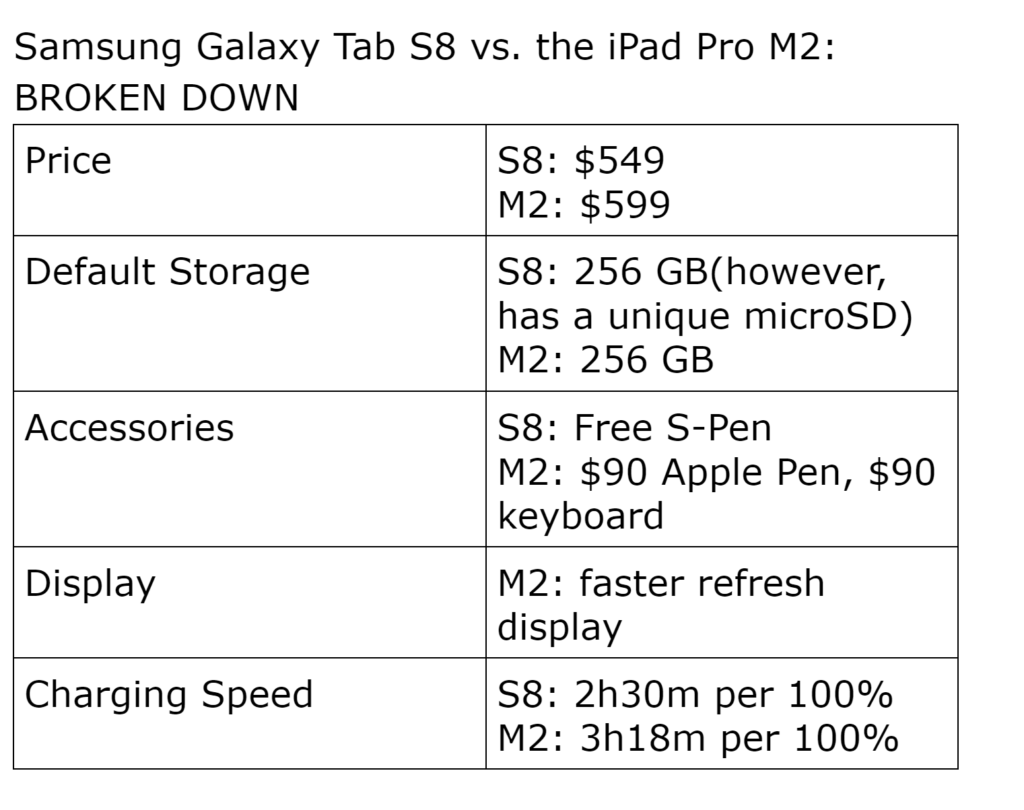It all started when I felt my backpack becoming far too heavy and uncomfortable to carry around. My back and shoulders sagged beneath a heap of binders, notebooks and writing utensils scattered in my decade-old bag. Stray papers went missing, often lost in the bottomless pit of homework assignments and stationery.
I needed a change.
I had to find a way to organize my materials and optimize the way I approached schoolwork. I was tired of not being able to conjure up papers that I needed at a second’s notice, or carrying an overfilled bag up Herriman Avenue every day. (Don’t walk to school as a senior, kids!)
I was told by friends and family that an iPad would be the solution to my problems. With its easy interface, excellent integrated writing software and flexibility to serve as a notebook and a computer all in one, the iPad seemed like an optimal solution.
First off, they look fresh. Apple has gotten their overall aesthetic, particularly with the newest generation of the device, fantastically on the dot. Their display is the best on the tablet market right now, and its UI has always been, and remains, excellent.
Also, its portability through the various in-screen fingerprint sensors and touch compatibility options offer far more utility than features from iPad counterparts like Samsung’s S6 and S8 tablets. Face ID also adds an easier accessibility to the iPad than continuing to type a passcode in, which Samsung requires.
In addition, Apple device-wide (except iPhone) USB-C ports are compatible with a new generation of cables, maximizing efficiency. The majority of iPads also coming with an attachable keyboard presents Apple’s hallmark tablet as a definitely appealing option, with a plethora of valuable traits.
Despite these benefits, when I searched around the internet and looked through web stores ranging from the official Apple store to eay and other more run-off sites, iPad prices looked absurd. The minimum I was seeing for the specifications that I wanted, which included a screen display greater than 10 inches, potential capability to add a keyboard on and ease-of-access UI, particularly for writing and note-taking, was around $450. Considering my desire to keep my purchase relatively low cost, I began to stray away from browsing for iPad deals. I simply couldn’t find trustworthy purchase options for less than the price I wanted while still maintaining all the key features I would have liked my device to possess.
Luckily, on another day when I was flipping through my old drawers, I discovered a viable alternative: my spare Samsung tablet. It had been stored away in an old drawer and accumulating dust for a reason — I didn’t see utility in using it. I thought that its “Samsungness” made it an inferior product. I was wrongly biased against the S6 lite, which has actually served me so well since then.
When I took the Samsung out one day just to test it, I was stunned by its capabilities. I was able to write smoothly with a built-in S-Pen. In comparison, the add-on of an Apple Pen costs $99! Ludicrous. A Samsung S8 in total can cost $199.
With my tablet, my Calculus homework, AP Lang notes and Physics problem sets were all carried conveniently on one device, instead of dispersed amongst three binders and notebooks.
The biggest perk I noticed about my Samsung tablet was that it provided a high quality and flexible note-taking app for free, default to every device. Apple’s default Notes app requires all sorts of extensions and installations before even becoming usable at a decent level. It is relatively primitive considering its inability to customize types of paper, convert written text to typed print and read downloaded PDF files with an ability to annotate them. Additionally, Notability and similar replacements on iPads come with a price.
In contrast, my Galaxy Tablet and others of its kind have a notes app that comes with the device. It’s accompanied with every form of paper possible, including graph sheets and music scores. Additionally, customization over possible finger writing and page extensions are all part of Samsung’s free applications. The iPad default app is far more limited, which is why users mostly resort to purchasing Notability to write.
Because many teachers upload PDFs of every assignment in their course onto Canvas, rather than having to parse through stacks of arbitrary papers in a desperate attempt to find what I need in a particular situation, I can simply download that PDF, annotate it and submit it.
The amount of paper Samsung’s default notes app offers as a template to start your notes is also amazing — it has graphs with four different scales, polar axes, music scores, binder paper, bulleted sentence templates, and calendars, among others. The iPad’s notes app simply does not possess this capability.
Another redeeming fact of the Samsung tablet is that the add-ons, such as the awesome S-Pen and newer accessories like the keyboard (for the latest generation of tablets), come at no additional cost. The pen can also be used on other Samsung tablet devices, something that the Apple pen is incapable of doing. The Samsung tablet’s hardware reigns superior over what Apple has to offer, with a faster refresh display, more storage because of its unique microSD holder and a better speaker and camera. In the world we’re in nowadays, where we need to speak and listen with our devices, those are key features where Samsung excels.
Lastly, charging speed is an underrated criterion when used to assess the quality of devices. The Samsung is able to charge at double the speed of an iPad due to its 45 Watt specs for supported wattage.
With students entering a more digital world and teachers simultaneously moving more material online, acquiring a relatively inexpensive tablet both optimizes the amount of content we have to carry to school every day and minimizes the potential for disorganization. The Samsung tablet, with its plethora of unique features, presents a far more viable option for students aiming to optimize the way they approach schoolwork, both in terms of pure quality and what a buyer would get, pound for pound, value for money.


























